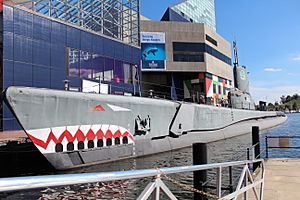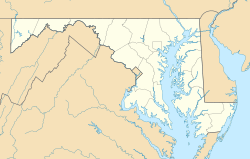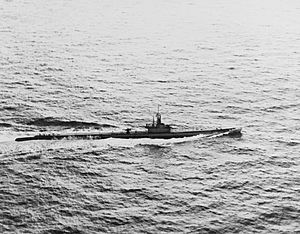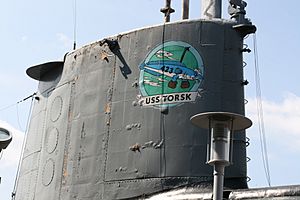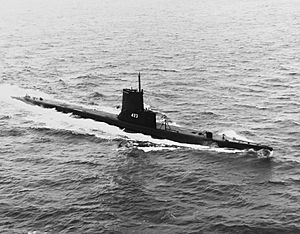USS Torsk facts for kids
class="infobox " style="float: right; clear: right; width: 315px; border-spacing: 2px; text-align: left; font-size: 90%;"
| colspan="2" style="text-align: center; font-size: 90%; line-height: 1.5em;" |
|} The USS Torsk (SS-423) is a famous submarine from World War II. It was built for the United States Navy. The Torsk is a Tench-class submarine. These submarines were an improved version of earlier, very successful submarines. The Torsk was built in 1944. It was finished and ready for action in December 1944.
In 1945, Torsk went on two war patrols near Japan. It sank one cargo ship and two small warships. One of these warships, sunk on August 14, 1945, was the very last enemy ship sunk by the U.S. Navy in World War II. After the war, Torsk became a training ship. It helped train sailors in the 1950s and 1960s. It also traveled to the Mediterranean Sea. The submarine was removed from active service in 1964. It then served as a training ship for the United States Navy Reserve for seven more years. In 1971, it became a museum ship. Today, it is part of the Historic Ships in Baltimore fleet.
Contents
| History | |
|---|---|
| Builder | Portsmouth Naval Shipyard, Kittery, Maine |
| Laid down | 7 June 1944 |
| Launched | 6 September 1944 |
| Commissioned | 16 December 1944 |
| Decommissioned | 4 March 1968 |
| Stricken | 15 December 1971 |
| Fate | Museum ship at Baltimore, Maryland, 26 September 1972 |
| General characteristics | |
| Class and type | Tench-class diesel-electric submarine |
| Displacement | |
| Length | 311 ft 8 in (95.00 m) |
| Beam | 27 ft 4 in (8.33 m) |
| Draft | 17 ft 0 in (5.18 m) maximum |
| Installed power | |
| Propulsion |
|
| Speed |
|
| Range | 11,000 nautical miles (20,000 km) surfaced at 10 knots (19 km/h) |
| Endurance |
|
| Test depth | 400 ft (120 m) |
| Complement | 10 officers, 71 enlisted |
| Armament |
|
|
USS Torsk
|
|
| Location | Pier IV, Pratt St., Baltimore, Maryland |
| NRHP reference No. | 86000090 |
| Significant dates | |
| Added to NRHP | 14 January 1986 |
| Designated NHL | 14 January 1986 |
- Building and Early Training (1944–1945)
- First War Patrol (1945)
- Second War Patrol and World War II's Last Shot (1945)
- Post-War Service and Training (1946–1971)
Submarine Design and Features
The Tench-class submarines were better versions of the earlier Balao and Gato-class submarines. These earlier submarines were very successful in the Pacific War against Japan. The Tench-class submarines were the last ones built by the United States Navy during World War II. They used lessons learned from earlier wartime experiences.
Size and Power
The Torsk was about 311 feet (95 meters) long. It was 27 feet (8.3 meters) wide. It could go as deep as 17 feet (5.2 meters) in the water. When on the surface, it weighed about 1,570 tons. When underwater, it weighed 2,414 tons.
The Tench-class submarines used four Fairbanks-Morse diesel engines. These engines powered electrical generators. This gave the submarine 5,400 horsepower when on the surface. It could reach a top speed of 20.25 knots (37.5 km/h) on the surface.
Underwater, the Torsk used two large batteries. These batteries powered two General Electric electric motors. The electric motors provided 2,740 horsepower. This allowed the submarine to go up to 8.75 knots (16.2 km/h) when submerged. On the surface, it could travel 11,000 nautical miles (20,000 km) at 10 knots. Underwater, its batteries lasted about 48 hours at 2 knots. The submarine could carry enough supplies for its crew for 75 days. It had 10 officers and 71 enlisted sailors.
Weapons and Armament
The Torsk was well-armed. It had ten 21-inch (533 mm) torpedo tubes. Six were at the front (bow) and four were at the back (stern). It carried a total of 28 torpedoes.
It also had a 5-inch (127 mm) deck gun on its top deck. For closer defense, it had Bofors 40 mm and Oerlikon 20 mm cannons.
Service History: Torsk at War and Peace
Building and Early Training (1944–1945)
The Torsk started being built on June 7, 1944. This happened at the Portsmouth Naval Shipyard. The main part of the ship was launched on September 6, 1944. The submarine was finished and officially ready for service on December 16.
From December 1944 to February 1945, Torsk practiced its skills. It then sailed to Florida for more anti-submarine tests. Soon after, on February 20, it headed for the Pacific Ocean. It passed through the Panama Canal and arrived in Hawaii on March 23. There, it prepared for its first war patrol.
First War Patrol (1945)
Torsk sailed to Guam and then to Japan. It arrived near Japan on May 11. Its first job was to look for American air crews. These were pilots who might have crashed during raids on Japan. No planes went down that day.
Later in May, Torsk joined other submarines. They patrolled the east coast of Japan. However, they did not find any Japanese ships. On June 2, Torsk saw a Japanese ship that laid mines. It fired torpedoes, but the ship dodged them. Two days later, it found a cargo ship. It fired more torpedoes, but missed again. Torsk then left the area and returned to Pearl Harbor for repairs.
Second War Patrol and World War II's Last Shot (1945)
Torsk started its second patrol on July 17. It sailed back to the Sea of Japan. On August 10, it went through dangerous minefields. The next day, it rescued seven Japanese sailors from a sunken merchant ship.
On August 12, Torsk found a small cargo ship and sank it with a torpedo. On August 13, it sank another small cargo ship. It tried to sink another one, but missed.
The most famous event happened on August 14. Torsk found a cargo ship with a small warship called a Kaibōkan. Torsk fired a new, experimental Mark 28 torpedo. This was a special torpedo that could find its target using sound. The torpedo hit the Kaibōkan and sank it quickly. Torsk then tried to sink the cargo ship, but missed.
Later that day, another Kaibōkan came to hunt for Torsk. Torsk fired another Mark 28 torpedo. It then dove deep to hide. It also fired a Mark 27 torpedo, which was a silent torpedo. Both torpedoes hit the Kaibōkan. This was the very last Japanese warship sunk in World War II. Japan announced it would surrender the next day. Torsk had to stay hidden underwater for over seven hours because other patrol ships were looking for it.
After Japan surrendered on August 15, Torsk continued patrolling. It watched Japanese bases and destroyed any naval mines it found. On September 9, it arrived in Guam, ending its second patrol.
Post-War Service and Training (1946–1971)
After the war, Torsk sailed back to the United States. It arrived in New London, Connecticut in October 1945. This became its home port for the next seven years. During this time, it mostly served as a training ship. It also took part in various tests and exercises. Torsk was used for training cruises for the United States Navy Reserve.
In 1950, Torsk went on a trip to the Mediterranean Sea. In 1951, its training took it to the Caribbean Sea. In 1952, the submarine received an upgrade called the Fleet Snorkel conversion. This allowed it to use its diesel engines while submerged, using a snorkel to get air. After this, it went on another Mediterranean trip.
Torsk was later moved to Norfolk, Virginia. From there, it helped train anti-submarine aircraft and surface ships. These ships and planes practiced finding and tracking submarines. Torsk often cruised in the Caribbean during this time. In June 1959, it visited the Great Lakes by way of the Saint Lawrence Seaway. It stopped at many ports in Lake Ontario and Lake Michigan.
In the 1960s, Torsk continued its Mediterranean trips. It also helped train anti-submarine forces of the Atlantic Fleet. It was part of the blockade of Cuba during the Cuban Missile Crisis in October 1962. The Torsk was officially taken out of service on March 4, 1964. It had served for almost twenty years. It was then used as a Navy Reserve training ship in Washington, D.C. It stayed there until 1971.
Torsk as a Museum Ship
The Navy gave Torsk to the state of Maryland on September 26, 1972. This was so it could be saved as a museum ship. It is now docked in the Inner Harbor of Baltimore, Maryland. It is part of the Historic Ships in Baltimore collection. On January 14, 1986, Torsk was named a National Historic Landmark. The Torsk and other historic ships are important parts of the Baltimore National Heritage Area.
Images for kids


